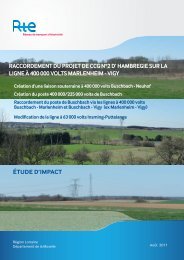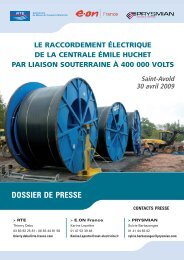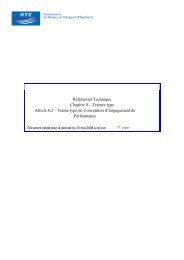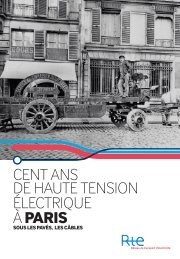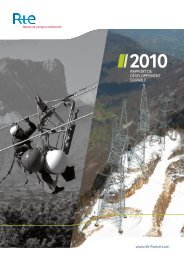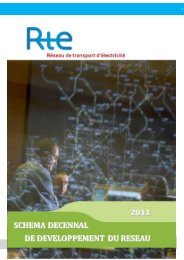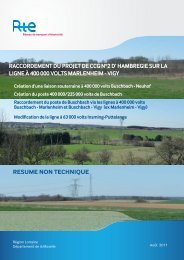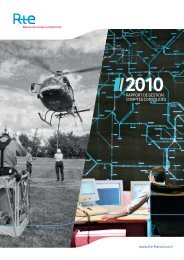Power System Reliability Report - RTE
Power System Reliability Report - RTE
Power System Reliability Report - RTE
- No tags were found...
Create successful ePaper yourself
Turn your PDF publications into a flip-book with our unique Google optimized e-Paper software.
R-AUDIT-SG-DAR-MAS-11-2011/022010 <strong>Reliability</strong> <strong>Report</strong>Page : 3/408 juillet 2011Summary of the 2010 <strong>Reliability</strong> <strong>Report</strong><strong>RTE</strong> publishes a yearly reliability report based on a stable model to facilitate comparisons and thedetection of long-term trends. The 2010 reliability report highlights the main elements concerningelectrical system reliability without being limited to a factual report of Significant <strong>System</strong> Events (ESS),which are ranked on a 7-level scale (0, then A to F).A- Operating situations encounteredIn the context of a cold winter season, the maximum consumption level of 96,700 MW was reachedon December 15 th at 19:00, with a mean temperature 6.3°C lower than average climatic conditions.The temperature gradient in winter reached 2300 MW/°C. The operating landscape was characterizedby contrasted import/export situations, varying rapidly on a daily and intraday basis as a result ofsupply & demand balance optimisation at a European scale, linked to production and consumptionparameters (e.g.: sensitivity of French consumption to meteorological conditions, increasing volume ofintermittent production, etc.).A-1 Supply / demand balance managementThe consumption forecasting activity‟s performance results are comparable to previous years, with 3ESS level A for underestimations of between 3300 and 3500 MW. The need for intraday reforecasts toreduce the forecasting gap is growing with the increase in load sensitivity to weather conditions.For the supply & demand balance, which results from demand and the positioning of marketparticipants, <strong>RTE</strong> encountered situations with upward insufficient margins evaluated for several hoursahead, leading to 18 ESS level 0, an identical result to 2009. There were no major difficulties in overallsupply & demand balance in 2010 (abstraction of network congestion situations) although several verycold days were quite tense.For several years now, the frequency stability of the European interconnected system, a value (?)shared by all companies and TSO‟s, has been, and remains, a serious concern. This was confirmed in2010, but the total duration of exposure to a serious risk due to a major production loss remainedlimited to 6400 seconds over the year, with a maximum event duration of 6 minutes and 20 seconds.The setting up of a European task force in 2010, with all the types of concerned actors, finally gaverise to encouraging prospects for the reduction of this risk in future.A-2 Flow and voltage profile managementAs in previous years, the main operating challenge for <strong>RTE</strong> was to guarantee reliability in the face ofthe risk of voltage collapse, in particular at high consumption levels, due to structural limitations –production localisation, difficulties in building new production facilities, growing consumption levels –mainly in the West region, while the situation in Provence Alpes Côte d‟Azur (PACA) improved with thecompletion in mid-2010 of the 400 kV double line supplying eastern PACA and the reinforcement ofproduction in the Fos area. These structural difficulties were worsened as of 2009 by substantiallimitations in the reactive power production capacities of generating units compared with contractualcapacities. These limits were generally only slightly reduced in 2010, decreasing from 6500 MVAr atthe end of 2009 to roughly 5000 MVAr at the end of 2010. Given this situation and the requests from<strong>RTE</strong>, the producer agreed in January 2011 to define a “multi-year plan to bring the units back toconformity” and to study the implementation of transitional protocols to provide additional capacityfrom certain constrained units over short periods. <strong>RTE</strong>‟s awareness of a reliable schedule to return toconformity is essential to decide on additional investments in reactive power compensation.From a factual standpoint, to manage the voltage profile, <strong>RTE</strong> had to call on warning or safeguardmeans giving rise to 31 ESS level A (20 in 2009), of which 23 for the very tense passage ofconsumption peaks during cold periods, whose amplitude and duration were however not exceptional.The safeguard orders, issued when the consumption level is expected to exceed the limitguaranteeing reliability in case of the loss of a unit or a 400 kV line, were activated more than 15times, several times for a large West zone as far as the Ile de France and even in Picardie, ensuring areduction in consumption up to 1200 MW.Modifications to tools and organisations in 2010 made it possible to significantly improve decisionmaking for the activation of these orders, by basing them on dynamic collapse risk simulations carriedout on network situations in real time, via quasi instantaneous merging of system states recorded inCopyright <strong>RTE</strong>. This document is the property of <strong>RTE</strong>. Any communication, reproduction, publication even partial is forbidden without the express written authorisationElectricity Transmission <strong>System</strong> operator (<strong>RTE</strong>)




